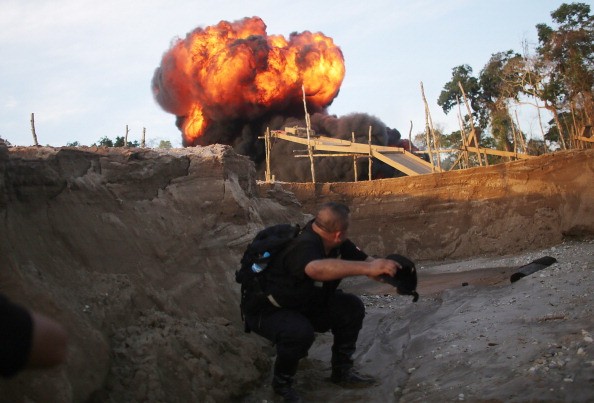
MADRE DE DIOS REGION, PERU - NOVEMBER 17: A National Police officer ducks as illegal mining operation equipment is destroyed in the Amazon lowlands on November. Police eventually destroyed three pieces of illegal mining equipment in the area. The biologically diverse Madre de Dios ('Mother of God') region has seen deforestation from gold mining in the area triple since 2008, when gold prices spiked during global economic turmoil. Small-scale miners are drawn to the area in hopes for higher pay but often face abysmal conditions. Gold is usually amalgamated with mercury during the process of informal mining in the region, which is discharged into the water supply and air, poisoning fish and sickening people in the area. Peru is the largest producer of gold in Latin America and the sixth-largest in the world. Informal mining accounts for roughly 20 percent of the gold production in Peru. (Photo : Getty Images)
Since 2008, the Peruvian government has been battling illegal miners. Amidst the wilderness of the Amazon jungle, explosives ravage the land, illegal prostitution oppresses the local population and disease spreads unmonitored.
In 2012, the Peruvian government passed legislation to curb the illegal gold mining rampant in its Amazonian departments. However, it did not fully enforce them until now. A deadline, which expired on April 25, allowed for illegal miners to register with the government. According to the AP, the government of President Ollanta Humala has vowed to enforce this latest deadline and will move against the remaining illegal miners.
There is an estimated 40,000 illegal miners in the gold mining regions, and they affect the local environment greatly. Mining operations outside government oversight have increased deforestation and have contaminated river systems, according to the news agency. Many indigenous tribes that have made little or no contact with Western civilization reside in the area and are susceptible to various diseases.
"We're not backing down even one inch," said Daniel Urresti, the former army officer leading the task for President Ollanta Humala, according to the AP.
Governor of the Madre de Dios department, Jorge Aldazabal, expects violence to erupt. He has been sleeping on a mattress on the streets to protest the illegal mining ravaging his department. The law will fine all illegal miners $54,000 and impose a sentence of up to 12 years.
According to the Wall Street Journal, Peru has been somewhat successful in quelling illegal mining. The 40,000 miners mentioned earlier are the remaining miners out of an estimated 110,000 that have failed to comply with the government. Registration would mean miners reporting their environmental impact to the government as well as paying taxes.
Peru highly depends on mining, reports the Journal, and the gold mining market is worth about $3 billion. Yet, Peru's process to legalize miners proves to be too cumbersome and bureaucratic for miners who began mining because they had no alternatives for income. Although not all miners fit this description, the illegal miners have banded together, blocking highways and protesting against the Humala administration. Whether Peru's attempts prove successful, we will have to wait and see.

Geen opmerkingen:
Een reactie posten